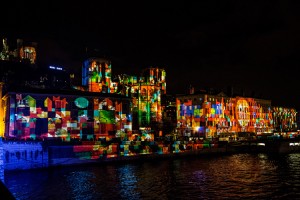Lyon’s Festival of Lights
December 6, 2019
Yesterday, December 5, the annual Festival of Lights (Fête des Lumières) began in the central French city of Lyon. The four-day festival, which dates back to 1852, is famous for the many light installations that illuminate the city. Houses in Lyon display candles in their windows during the festival, and public buildings and structures glow with elaborate and colorful light patterns. Traditionally, the festival marks the Feast of the Immaculate Conception (December 8), an important event on the Roman Catholic calendar.

Waterfront buildings glow during the Festival of Lights in Lyon, France. Credit: © Nicotrex/Shutterstock
The festival’s roots date back to the 1600′s, when the city was spared from an outbreak of the plague. In thanks, city officials began an annual tribute to the Virgin Mary, the mother of Jesus. In 1852, after a period of social unrest and recurring floods, a statue of Mary was unveiled on December 8 on Lyon’s Fourvière Hill. Poor weather delayed the ceremony until nightfall, and the people of Lyon lit candles to illuminate the event, honor the Virgin Mary, and show a spirit of solidarity. The lighting of candles on December 8 became the Festival of Lights, then, which expanded with the advent of electric light in the late 1800′s.
By the 1960′s, the Fête des Lumières had grown to include shop window lighting competitions marking the start of the Christmas season. In 1989, Lyon adopted an artistic lighting policy (the Plan Lumière) throughout the city, with particular attention paid to the city’s historical buildings and landmarks. Nearly all Lyon’s lovely parks and squares were soon aglow during the festival, as were the city’s bridges and banks along the Rhône and Saône rivers. Today, more than 2 million people attend the festival every year.
Lyon was founded in 43 B.C. by Roman soldiers. The town, then known as Lugdunum, served as an important administrative center of the Roman Empire until the middle of the A.D. 200′s. Lyon became part of the kingdom of France in the early 1300′s. During the 1400′s, the city became a prosperous trading and banking center and home to many book printers. The introduction of silk manufacturing from Italy in the 1500′s brought greater, and long-lasting, prosperity. Lyon was a center of French resistance to German occupation forces during World War II (1939-1945).


